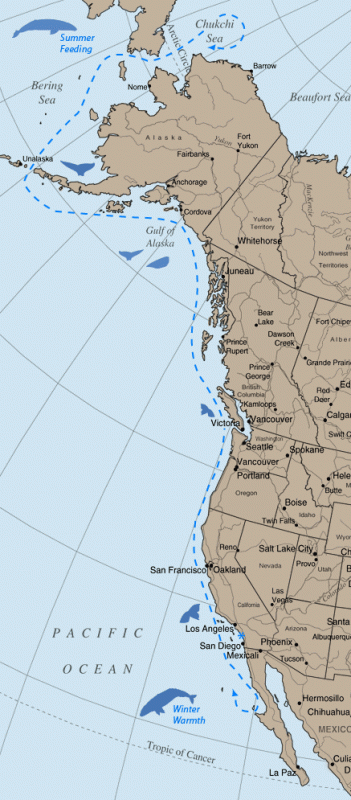Gray whales, Blue whales, Sperm whales, Orcas, and Humpbacks all live along the Pacific coast. Migration of the Gray whale happens each year – twice! These spectacular creatures travel in small pods north to their feeding grounds of Alaska then return south to the warm breeding lagoons of Baja California, Mexico. During their journey of over 5,000 miles, Gray whales can be spotted about a mile off Seabrook’s beach and other Washington coast beaches.
Here Are Some of the Basics for Whale Watching
The Gray whale can be up to 50 feet in length and weigh 80,000 pounds, which makes them easy to spot from the shoreline, an oceanside Seabrook rental home, or a Seabrook townhome in the town center (with binoculars, spotting scope, or telescope if necessary). You may first notice spray because Gray whales spout a jet of vapor when they surface. This misty spray can fountain up to 12 feet in the air. It looks like water, but it is really compressed air expelled from the whale’s lungs.
There are also many public beaches and state parks via SR 109 to watch for whales from Copalis Beach to Pacific Beach State Park up to Destruction Island Viewpoint (about a mile south of Ruby Beach, which is 68 miles from Seabrook). The Whale Trail is a great resource for whale watching along the Pacific coast.
Whale watching is just one of many wildlife outings you can experience in the Olympic National Park.
If you’re interested in culture, history, and whale exhibits, check out the Westport Maritime Museum in Westport just 50 miles from Seabrook. Also, Ocean Sportsfishing Charters in Westport offers whale watching tours, plus all types of fishing charters.
Before watching for whales from the shoreline, check the tide tables at Tides and Currents NOAA, Point Grenville, WA.
The best time to watch whales on the Washington coast is the beginning of March through May during their migration north to the feeding waters of Alaska, the Bering Sea and Chukchi Sea.
Gray whale migration

10 FACTS TO SHARE
- Orcas (Killer whales) are alpha predators (or apex predators), which means they are at the top of their food chain and have zero natural predators. Other alpha predators include tigers, lions, and Great White sharks.
- At 13 to 20 feet, Beluga whales are one of the smallest species of whales, and there are more than 80 whale species.
- Unlike Gray whales who swim in small groups (pods), Blue whales travel alone or in pairs.
- Blue whales are one of the loudest animals on earth and can hear each other up to 1,000 miles away.
- Gray whales live between 50 and 70 years.
- A baby Gray whale can consume as much as 80 gallons of milk per day.
- Early ancestors of the Gray whale existed over 30 million years ago.
- It is estimated that there are now over 22,000 Gray whales! In the early 1900’s, they were considered close to extinction.
- Today, Gray whales are protected by international law, and their numbers have grown. In 1994, the Gray whale was removed from the United States endangered species list.
- Whale watching is so big in South Africa that the town of Hermanus has a designated “whale crier” to blow a horn that alerts people whenever a whale is spotted.
Sources: Summaries of numerous corroborative websites.
